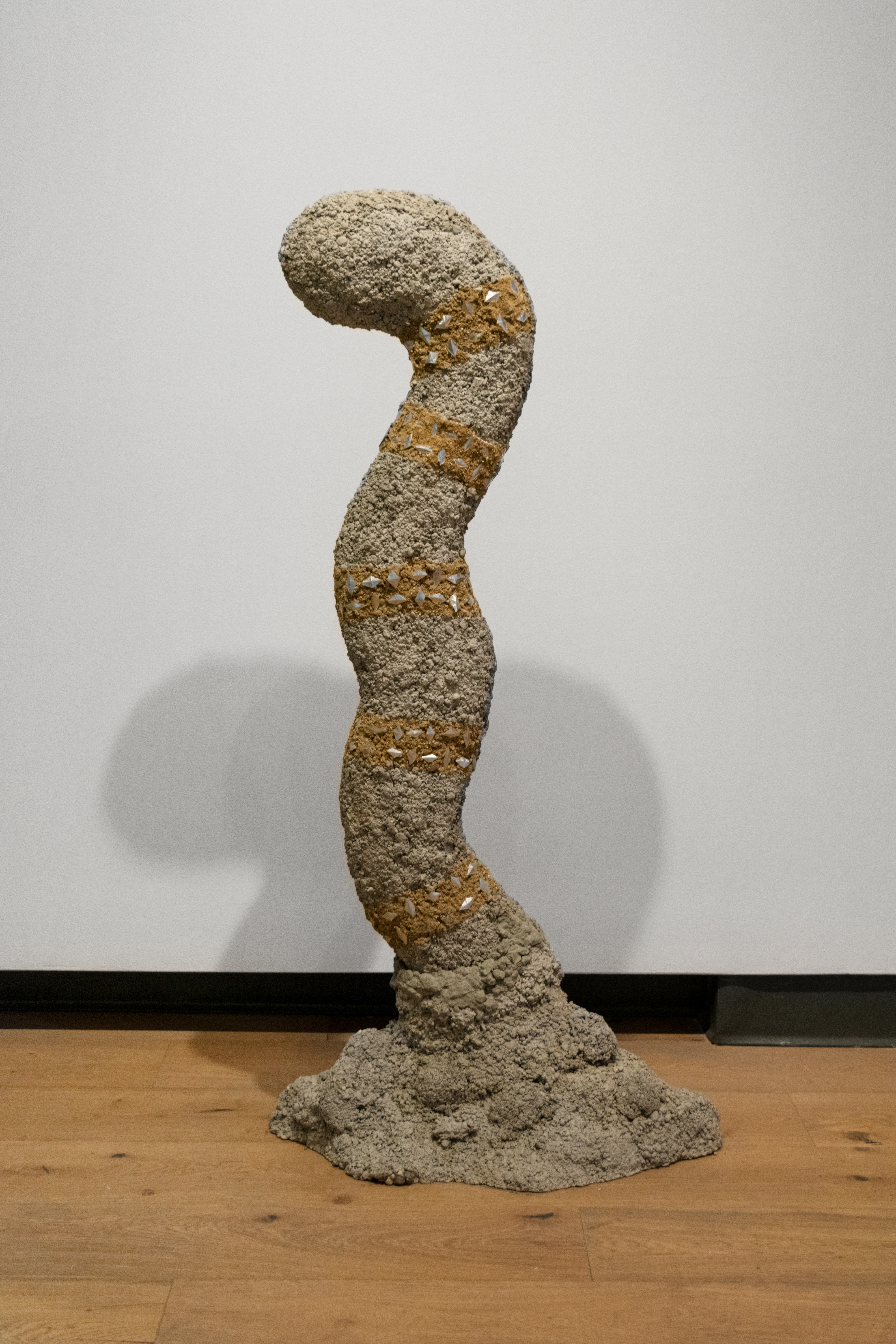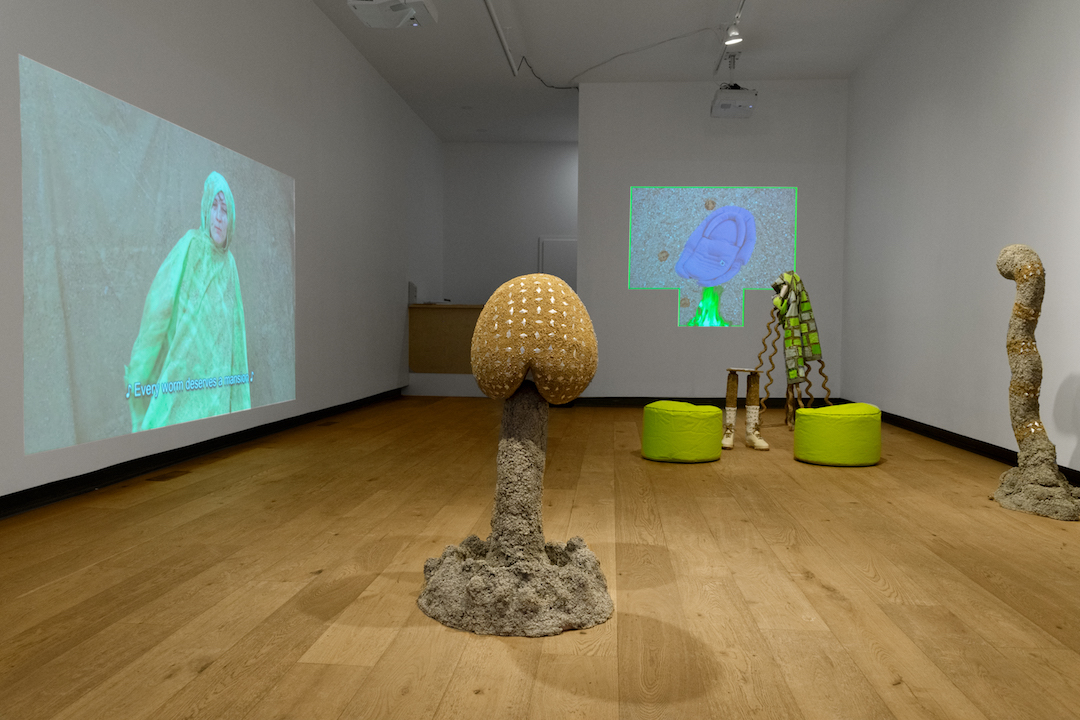MAINSPACE EXHIBITION /

Every Worm Deserves a Mansion
Nicole Brunel
March 7–April 18, 2020
Exhibition Description /
Beside a wall of sand, a Mountain Dew-patched character of confusing age tells bad jokes to no one. An audience of sculptures stands silently; a giant worm, an effigy to stink bombs, and a puzzle from the 123rd dimension. These statues are bodily in form, idolized jokes constructed from the infrastructural detritus of a city buried by a desert. The metal is reused, concrete is rotten, and sand is hot and mutant. String encrusted by this sand tries to stand and lift. Bows mark points of interdimensional intersections. Cookie marks the spot. Mom is missed.
In the distance, a visible suspension of carbon can be seen coming from a camp. Its fire is still glowing but no one’s sure how long it’s been here. There are traces of human and baby energy left to be decoded; a green screened turtleneck, a 4:3 mushroom cloud, and keyframed soft marble car seats. Touching the sand here, it’s ticklish and trying its best not to tell a secret. The fire betrays this intention, emitting a digital language translated through smoke. Fuzzy and looping narrators act as guides through puzzles in the plume. Every Worm Deserves a Mansion is a prediction and a recounting of a sugar-fueled ascent to the nth dimension.





Exhibition Text /
1) In her essay regarding Edgar Arceneaux’s The
Alchemy of Comedy…Stupid (2006), Lorelei
Stewart argues, “We cannot deny our legacy,
our inheritances, but we can determine how they
get retold. Turn them into malapropisms or
punchlines.” 15-some-odd years later, in a
cultural, social, political, and ecological
landscape that is fraught with turmoil and
destruction (to say the least), a combo of
malaprops and punchlines may be too flimsy a
strategy to correct the deeply systemic ills that
face us in 2020.
The humor of Every Worm Deserves a Mansion
may follow a similar train of thought to
Arceneaux’s, but it seeks to delink and complicate
its relationship to linearity. Where the comedic
and artistic strategies of the mid-aughts were
still attempting to make peace with some notion of
stability or convention, Brunel interrogates the
basis of continuity itself – destabilizing the
viewer’s relationship to order or sense. The
humor is in the rhythm of convention’s
breakdown, finding its niche in the space where
language becomes nebulous.
Brunel’s work mucks around in the residue of the
in-between, challenging the conventions of
sense and non-sense – asking what happens if
they touch. What if a joke becomes a sculpture
and then tries to become a joke again? Is it still
funny? What’s funny? What’s so funny!?! Hehe
haha hoho huh?
Material acts as an anchor to make the nonlinear
linguistic and conceptual textures all the
weirder. Where isn’t the sand? Where isn’t
sand? Why isn’t there sand where there isn’t
sand? Where is sand supposed to be anyhow?
The work remains in a constant state of
transition – in between talking and singing, in
between anxiety and humor, in between
laughing and crying, in between together and
alone, in between action and cut. Brunel
challenges us to not only sit in the tension of
that space, but to examine the hierarchical modes
inherent to its uncomfortability. A yearning to
make sense – to make order.
2) The pedagogy of counting; I tell our 4-year-old:
“I’m going to count to 3 and if you don’t turn
the TV off a toy is going on timeout.”
They look up at me – a delay.
“oneeeeee…twoooo…twoandahalffff”
They jump off the bed – frantically trying to find
the on/off button on the remote.
“andddd…threeeeee”
A 3-count method for kid control seems as old
as the hills. An incredibly simple, direct, and
efficient system for refocusing/reshaping a
child’s behavior. A parent or guardian locates
the potential punishment at a point within a
counting sequence – if the child understands the
direction the numbers are moving in, they
understand that the punishment is located in
time. They can change their behavior but not the
existence/nonexistence of the punishment. This
simple count proves to be a critical stage in the
child’s initiation into personhood, where the
fluidity of their lived experience is traded in for
the strictures of obedience.
You! You believe that if something exists, it
exists on the Internet. You operate day-to-day
under the pretense that Spotify is an archive of
all recorded music, that YouTube is the
repository for all film/video footage, that if a
book has been published, you will be able to
find it on Amazon. And maybe you’re right, but
not yet.
1 begets 2 begets 3 begets ______. Is there even
a question here? You were able to answer that.
It even seems silly to imply that there was any
time in between the question and the answer – it
answered itself and you were the conduit.
Before long, our 4-year-old will be a conduit
too – no time, no thinking – just doing. But for the
time being, they resist. They resist by subverting
the count.
3) Every Worm Deserves a Mansion won’t sit still –
won’t stop shifting. The movement fidgets
between impatience, excitement, frustration, and
delight. In Hole Theory (2001-2002), William Pope.L
proclaims, “…aesthetic expression makes
visible contradiction- being opposed, being
against- lacking belonging, lacking home or a
being ‘at home’ from which overcoming or
transcendence might be accomplished.” Brunel
builds on Pope.L’s proclamation, offering us
coping strategies couched in tonal oppositions.
A punchline becomes radical as it offers an
alternative to the 1-2-3 of it all. “I’ve got a 9-
inch dick if you count the butthole,” Brunel
remarks to camera. A deceivingly simple one-
liner is, in fact, a challenging and sophisticated
comment on the intersection of gender, the
quantification of body, and heteronormative
predilections. Brunel’s work is chock-full-o’-
nuggets like these; extended and repeated
viewings are highly suggested.
Biographies
Nicole uses sculpture, music, video, and coding to create spaces of alternate reality. These spaces are defined by mutability; of identity, of humour, and of dimension.Their stories speak of similarities between non-binary gender, wave-particle duality, and carabiners.
Christopher Robert Jones is an interdisciplinary artist and writer based in Illinois. Their research is centered around the ‘failure’ or ‘malfunctioning’ of the body and how those experiences are situated at points of intersection between queer and crip discourses. Using sculpture, installation, textual, and performance strategies, their work aims to create ruptures in the layers of cultural/political/historical sediment through which compulsory normativity and compulsory ablebodiedness are disseminated. Christopher received B.A.s in Art Studio and Technocultural studies from UC Davis and is currently a M.F.A. candidate at the University of Illinois in Urbana-Champaign.
Territorial Acknowledgments
TNG gratefully acknowledges its home on the traditional territories of the people of the Treaty 7 region, including the Blackfoot Confederacy (Kainai, Piikani and Siksika), Métis Nation of Alberta Region III, Stoney Nakoda First Nation (Chiniki, Bearspaw, and Wesley), and Tsuu T’ina First Nation. TNG would also like to acknowledge the many other First Nations, Métis and Inuit who have crossed this land for generations.
This exhibition was generously supported by the Canada Council for the Arts and the Rozsa Foundation.

Translated Catalog: Traditional Chinese / Simplified Chinese
